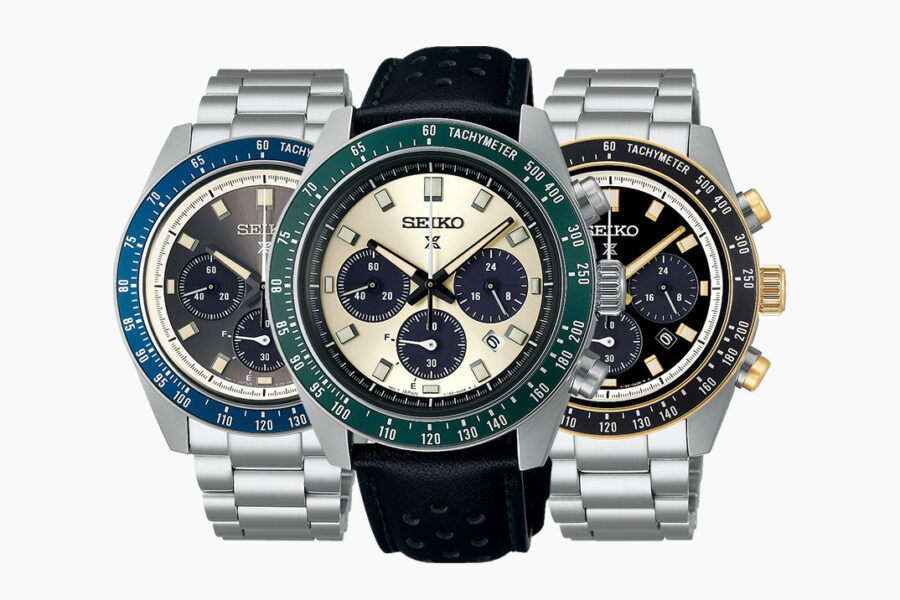Celebrating its 55th anniversary this year, Seiko’s Speedtimer was the world’s first-ever automatic chronograph watch when it debuted in 1969, sporting a column wheel and vertical clutch in the movement for more accurate time-telling. And while the Speedtimer continues to evolve with the changing times, it’s always done a great job of blending retro and modernity. Playing frequent host to limited- and special-editions, the Prospex line in which the Speedtimer sits is one of our favorites for how it toes the line between budget and luxury while also imbuing its releases with a healthy dose of sports influence.
For its latest release, Seiko is tapping into its motorsports background, with a trio of Prospex Speedtimers, each with a visual focus on a different aspect of the racing world.
Watches and Cars
If you spend any time in either industry, you’ll notice a lot of crossover when it comes to watches and cars. Both sharing the same passion for tradition, complex engineering, and intricate use of mechanics, the two products have been seemingly linked together since the dawn of the automobile. During the motorsports heyday in the ‘60s and ‘70s, the connection grew stronger. Drivers and crew members needed ways to time races and looked to the growing world of chronographs from the likes of Rolex, Heuer, and Seiko, just to name a few.
A new aesthetic grew from this bond and today there is a very specific look to “racing chronographs.” As far as Seiko is concerned, their Speedtimer was a beloved model throughout the ‘70s, with fans today appreciative of the new editions that the Japanese watchmaker continues to come out with.
The Watches
Based on the structure and configuration of the retro-inspired Speedtimers that were introduced back in 2022, these three new timepieces share the same specs and tricompax layout but differ when it comes to the color schemes and bands. They also feature tachymeter bezels for measuring speed and hour and minute hands that harken back to the original 1969 Speedtimer. Housed in 41.4mm stainless steel cases, the watches are powered by the caliber V192 solar-powered movement — a rarity in the chronograph world. This will give you 6 months of power when fully charged by the sun.
As we mentioned, each of these pieces connects to a different aspect of ‘70s motorsports culture, and thus has different names. Two of the watches feature three-link stainless steel bracelets. Decidedly European in influence, the “Grand Touring” edition sports a navy blue aluminum bezel around a dark gray dial with midnight blue registers and a cream chapter ring. Meanwhile, the “Circuit Race” edition is at the top end of this release, with a black aluminum bezel that’s been framed in gold plating. The dial is also in black with the midnight blue totalizers and cream chapter ring. However, the crown and pushers feature an exciting gold plating as well, matching the marquee draw of the reference’s namesake circuit races.
Subjectively, the highlight of the set also happens to be the cheapest. Dubbed “Racing Sports,” the timepiece features a dark green aluminum bezel with a cream-colored dial, midnight blue chronograph registers, and a black chapter ring. However, the star of the show is the black punched calfskin leather strap, which was a hallmark of old racing chronographs and a first for the Speedtimer collection.
Case Size: 41.4mm
Case Thickness: 13mm
Case Material: Stainless steel
Water Resistance: 100m
Movement: Solar-powered chronograph
Band: Perforated calfskin leather or stainless steel
Limited Edition?: No
Pricing & Availability
Not limited in edition size, the Seiko Solar Speedtimer Chronograph Classic Motorsports are currently available from Seiko’s website and range from £590 (~$739) to £620 (~$777). Deliveries are expected for this June.
Seiko Solar Speedtimer Chronograph Classic Motorsports
Seiko looks back at ’70s motorsports with a trio of Prospex Speedtimer Solar Chronographs, each highlighting a different aspect of that era, from grand touring to circuit racing.









